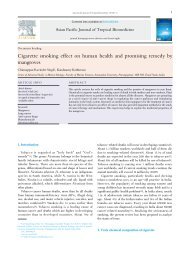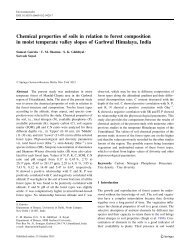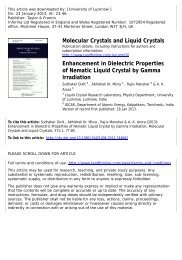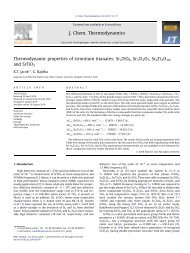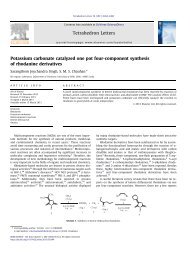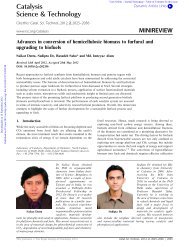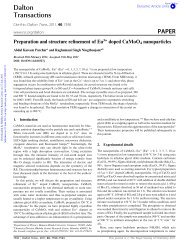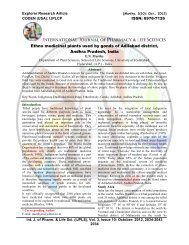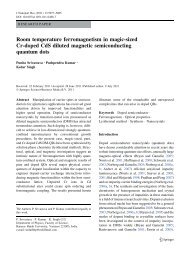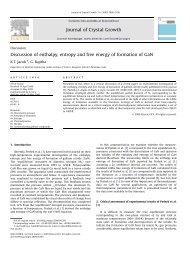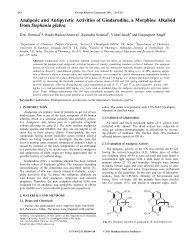Synthesis and Characterization of Co-Doped Ceria Ceramics by Sol ...
Synthesis and Characterization of Co-Doped Ceria Ceramics by Sol ...
Synthesis and Characterization of Co-Doped Ceria Ceramics by Sol ...
Create successful ePaper yourself
Turn your PDF publications into a flip-book with our unique Google optimized e-Paper software.
Trans. Ind. Ceram. Soc., 70 (3) 143-147 (2011).© 2011 The Indian Ceramic Society<strong>Synthesis</strong> <strong>and</strong> <strong>Characterization</strong> <strong>of</strong> <strong>Co</strong>-<strong>Doped</strong> <strong>Ceria</strong><strong>Ceramics</strong> <strong>by</strong> <strong>Sol</strong>-Gel MethodS. Ramesh*, K. C. James Raju <strong>and</strong> C. Vishnuvardhan Reddy**School <strong>of</strong> Physics, University <strong>of</strong> HyderabadHyderabad – 500 046, AP, India[MS received June 14, 2011; revised copy received August 24, 2011]<strong>Doped</strong> <strong>and</strong> co-doped ceria electrolyte materials are very useful in solid oxide fuel cells. The Ce 0.9 Sm 1–x Sr x O 2(x = 0-0.09) compositions were synthesized through the sol-gel method. Dense Ce 0.9 Sm 1–x Sr x O 2 ceramics wereobtained through sintering the pellets at 1300 o C for 8 h. XRD measurements indicate that all synthesized materialscrystallized in cubic fluorite-type structure. Average crystallite size <strong>of</strong> the samples was in the range 21-27 nm. Therelative density <strong>of</strong> Ce 0.9 Sm 1–x Sr x O 2 samples was over 94% <strong>of</strong> the theoretical density. The lattice parameter increasedlinearly with increasing Sr concentration in Ce 0.9 Sm 1–x Sr x O 2 following Vegard’s rule. Surface morphology wasanalyzed using SEM. It was observed that the thermal expansion increased linearly with increasing temperature.The two-probe a.c. impedance spectroscopy was used to study the grain, grain boundary <strong>and</strong> total ionic conductivity<strong>of</strong> doped <strong>and</strong> co-doped ceria in the temperature range 250 o -500 o C. The Ce 0.9 Sm 0.07 Sr 0.03 O 2 composition showedhigher grain ionic conductivity <strong>and</strong> minimum activation energy at 500 o C.[Keywords : Oxides, <strong>Sol</strong>-gel process, Impedance spectroscopy, Ionic conduction, Activation energy]Introduction<strong>Sol</strong>id oxide fuel cells are the energy converters; theyconvert chemical energy to electrical energy. Recentlysolid oxide fuel cells (SOFC) have been attracting moreattention due to high efficiency <strong>and</strong> clean energyconversion. Yttria-stabilized zirconia (YSZ) is a st<strong>and</strong>ardelectrolyte for solid oxide fuel cell applications. Highoperating temperatures (1000 o C) are required toincrease the ionic conductivity <strong>of</strong> YSZ. However, at suchhigh operating temperatures there are some problemslike thermal mismatch between cell components,chemical instability, selection <strong>of</strong> materials, etc. 1, 2<strong>Doped</strong> ceria electrolytes showed higher ionicconductivity in the temperature range 350 o -700 o C. Amongthe various dopants studied samarium doped ceria (SDC)has been reported to have the highest ionic conductivity. 1<strong>Ceria</strong> doped with heterovalent cations, such as rare earth<strong>and</strong> alkaline earth ions, have been extensively studied asthe most promising electrolyte materials for intermediatetemperature solid oxide fuel cells (IT-SOFC). 1As reported in the literature 3–9 it is evidenced that codopingcould improve the ionic conductivity. Dopant ion,dopant concentration, oxygen vacancy concentration,defect association energy <strong>and</strong> local defect structure arethe factors, which can influence the ionic conductivity indoped ceria. 1, 2, 10 As reported, 1 for single doped ceria incase <strong>of</strong> rare earth materials, Ce-Sm or Ce-Gd are the bestcombinations; similarly in case <strong>of</strong> alkaline earth materials(Ca, Sr), Ce-Ca or Ce-Sr are the best combinations. In thepresent study we have selected Ce-Sm-Sr (co-doped)*<strong>Co</strong>rresponding author; e-mail: ramesh_ou10@rediffmail.com**Department <strong>of</strong> Physics, Osmania University, Hyderabad – 500 007,AP, Indiacombination <strong>and</strong> changed different dopant concentrationsto identify proper electrolyte composition for SOFCapplication.In the present paper, Sm 3+ <strong>and</strong> Sr 2+ co-doped ceriabased materials, Ce 0.9 Sm 1–x Sr x O 2 (x = 0-0.09), areprepared <strong>and</strong> characterized. The effect <strong>of</strong> co-doping onstructure <strong>and</strong> electrical conductivity is studied incomparison with samarium-doped ceria, Ce 0.9 Sm 0.1 O 2 , inthe temperature range 250 o -500 o C.ExperimentalThe samples with the general formula Ce 0.9 Sm 1–x Sr x O 2(x = 0-0.09) were synthesized through sol-gel method. Highpurity cerium nitrate hexahydrate (Ce(NO 3 ) 3 6H 2 O),samarium oxide (Sm 2 O 3 ) <strong>and</strong> strontium nitrate(Sr(NO 3 ) 2 .4H 2 O) were used as the starting materials.Stoichiometric amount <strong>of</strong> samarium oxide powder wasmixed with nitric acid in a beaker labelled as ‘solution A’<strong>and</strong> placed on a heater at 45 o C; slowly the evolution <strong>of</strong>white gas fumes occurred <strong>and</strong> disappeared resulting in athick transparent solution. This was an indication that thesamarium oxide has been converted into samarium nitrate.Stoichiometric amounts <strong>of</strong> Ce <strong>and</strong> Sr nitrates weredissolved in distilled water under continuous stirring in abeaker labelled as ‘solution B’. ‘<strong>Sol</strong>ution A’ was then addedto ‘solution B’ <strong>and</strong> stirred properly. Citric acid was addedto the whole solution in 1:1 molar ratio. Then ammoniumhydroxide was added drop <strong>by</strong> drop to the solution to adjustthe pH to ?7. After adjusting pH, the whole mixture wasstirred at 70 o C for 10 to 14 h <strong>and</strong> a homogeneous solutionwas then formed. With the evaporation <strong>of</strong> water, ethyleneglycol was added to the solution in the molar ratio 1:1.2<strong>and</strong> heated at 85 o C. After 8-12 h a brownish sponge typeviscous gel was formed. The gel was placed in a burner.VOL. 70 (3) JULY – SEPTEMBER 2011 143
Slowly the gel started to foam, swell <strong>and</strong> finally burn withglowing flints <strong>and</strong> the evolution <strong>of</strong> large amounts <strong>of</strong> gasoccurred. This auto ignition was completed within a fewseconds, giving rise to a light yellow coloured ash, whichwas calcined at 600 o C for 2 h to remove the carbonaceousmaterials <strong>and</strong> to obtain the most stable mixed oxide phase.Oxidation <strong>of</strong> Ce 3+ to Ce 4+ occurred during this stage. 11 Theresultant ash was ground in agate mortar to get a finehomogeneous powder.The powders were pressed uniaxially with the help <strong>of</strong>a hydraulic press under a continuous pressure <strong>of</strong> 5 MPainto a circular pellet (10 mm in diameter <strong>and</strong> 2 mm inthickness). Then the pellets were sintered in air at 1300 o Cfor 8 h. The densities <strong>of</strong> sintered samples were measuredin xylene using the Archimedes method. The sinteredsamples have more than 94% <strong>of</strong> the theoretical density.X-ray diffraction patterns <strong>of</strong> the samples were measured<strong>by</strong> PANalytical X’Pert Pro X-ray diffractometer (XRD) usingCuK? radiation in the Bragg’s angle range <strong>of</strong> 20 o ? 2? ?80 o . Lattice parameter was calculated <strong>by</strong> XLAT s<strong>of</strong>tware.ZEISS FE-SEM was used to scan the surface. The thermalexpansion measurements were carried out with Netzschpush-rod dilatometer (DIL; model: Netzsch DIL 402 PC,Germany) at a constant heating rate <strong>of</strong> 5 o C.min –1 in thetemperature range 30 o to 600 o C. The rectangular samples<strong>of</strong> dimension 25 ? 6 ? 6 mm 3 were used for thesemeasurements. Electrical impedance (Z) <strong>and</strong> phase angle(?) were measured using LCR Hi-Tester (HIOKI 3531Z) inthe frequency range from 42 Hz to 5 MHz. Z-view s<strong>of</strong>twarewas used to analyze the impedance data <strong>and</strong> to calculatethe grain resistance <strong>of</strong> the samples. Electrical conductivitymeasurements were conducted at various temperaturesin the range 250 o -500 o C in air. Silver paste was brushedto each side <strong>of</strong> the samples, which was subsequently driedat 600 o C for 20 min, producing solid silver electrode onboth sides <strong>of</strong> the pellet.Results <strong>and</strong> DiscussionStructure AnalysisFigure 1 shows XRD patterns <strong>of</strong> Ce 0.9 Sm 1–x Sr x O 2system. It is clear that the powders contain only a cubic–fluorite structure with the space group Fm3m (JCPDSpowder diffraction file no. 34-0394). The crystallite size(D XRD ) is calculated using the Scherrer equation,D XRD = 0.9? / ?cos? ..(1)where ? is the wavelength <strong>of</strong> the radiation, ? is thediffraction angle <strong>and</strong> ? is the full wave half width maxima.The crystallite size <strong>of</strong> Ce 0.9 Sm 1–x Sr x O 2 samples was in therange 21-27 nm. Figure 2 shows the lattice parameter asa function <strong>of</strong> dopant concentration (x). It is noticed thatthere is a linear relationship between lattice parameter (a)<strong>and</strong> dopant concentration (x) in Ce 0.9 Sm 1–x Sr x O 2 . Therelationship can be expressed asa(x) = 5.4232 + 0.2233x (Å) ..(2)INTENSITY (a.u.)(111)(111)(200)x = 0.09x = 0.06x = 0.03x = 0.00(220)(311)(222)(400)(331)(420)20 30 40 50 60 70 802? (degree)Fig. 1 – XRD patterns <strong>of</strong> Ce 0.9 Sm 1–x Sr x O 2 systemLATTICE PARAMETER (Å)5.4455.4405.4355.4305.4255.420R-square: 0.99930.00 0.03 0.06 0.09DOPANT CONCENTRATION (x)Fig. 2 – Lattice parameter <strong>of</strong> Ce 0.9 Sm 1–x Sr x O 2 systemThis shows the validation <strong>of</strong> Vegard’s rule. The introduction<strong>of</strong> Sm 3+ <strong>and</strong> Sr 2+ into Ce 4+ can cause a small shift in theceria peaks. This shift is indicative <strong>of</strong> a change in the latticeparameter. This is due to the difference in ionic radii <strong>of</strong>Ce 4+ (0.96 Å), Sr 2+ (1.21 Å) <strong>and</strong> Sm 3+ (1.08 Å) 12 in an oxidesolid solution. Results are consistent with the reportedliterature. 5–7Figure 3 shows the relative density versus differentsintering temperatures <strong>of</strong> Ce 0.9 Sm 1–x Sr x O 2 specimens.It can be seen from the figure that Sr <strong>and</strong> Sm codopedceria powders shrinks very fast since itsrelative density increases from 63-69% to over 93%in the temperature range 1100 o -1300 o C. Figure 4shows the SEM picture <strong>of</strong> Ce 0.9 Sm 0.07 Sr 0.03 O 2–?sample. It is very clear that the surface <strong>of</strong> the sampleis high dense. This is in good agreement with therelative density <strong>of</strong> the test samples.144 TRANSACTIONS OF THE INDIAN CERAMIC SOCIETY
1000.8RELATIVE DENSITY (%)908070600.000.030.060.09dL/L (%)0.60.40.20.000.030.060.09500.01000 1100 1200 1300TEMPERATURE ( o C)100 200 300 400 500 600TEMPERATURE ( o C)Fig. 3 – Variation <strong>of</strong> relative density as a function <strong>of</strong> temperaturefor Ce 0.9 Sm 1–x Sr x O 2 systemFig. 5 – Thermal expansion <strong>of</strong> Ce 0.9 Sm 1–x Sr x O 2 systemwhere ? ? T is the average <strong>of</strong> TEC in the temperature range<strong>of</strong> ? T, dL is the change <strong>of</strong> sample’s length in ? T, L is theoriginal length <strong>of</strong> sample. The calculated TECs arepresented in Table I. The decrease <strong>of</strong> TEC (after x = 0) isaccompanied <strong>by</strong> increase <strong>of</strong> lattice parameter. Presentresults are well matched with the literature. 5, 7Table I : Thermal expansion coefficients (TECs)<strong>of</strong> Ce 0.9 Sm 1–x Sr x O 2 system<strong>Co</strong>mpositionTEC (?10 –6 o C –1 ) at 600 o Cx = 0.00 12.01x = 0.03 12.32x = 0.06 12.17Fig. 4 – SEM picture <strong>of</strong> Ce 0.9 Sm 0.07 Sr 0.03 O 2 sampleThermal ExpansionFigure 5 shows the thermal expansion <strong>of</strong> Ce 0.9 Sm 1–x Sr x O 2 .The electrolyte materials for SOFC must have matchedthermal expansion coefficients for cathode <strong>and</strong> anodematerials to avoid a micro crack between anodeelectrolyte-cathodeat the operation temperature. FromFig. 5 it is noticed that the thermal expansion curvesare linear. Kumar et al. 5 have reported that the thermalexpansion depends on the electrostatic forces within thelattice, which depend on the concentration <strong>of</strong> positive<strong>and</strong> negative charges <strong>and</strong> their distances within thelattice. The thermal expansion coefficients (TEC) arecalculated from the expansion curves using followingexpressiondL? ? T = ..(3)L ??? Tx = 0.09 12.09Impedance SpectroscopyImpedance spectroscopy is a powerful tool to studythe electrical properties <strong>of</strong> solid electrolytes. The grain ionicconductivity is the fundamental material property, whereasthe total conductivity is related with the contributions <strong>of</strong>microstructure, impurity <strong>and</strong> other factors to the samples’resistance. In the present work grain ionic conductivity <strong>of</strong>materials is reported. Figure 6a shows the Nyquist plot <strong>of</strong>Ce 0.9 Sm 0.07 Sr 0.03 O 2 ceramic sample at 300 o C. Incompletedepressed arc, complete semi-circle <strong>and</strong> a part <strong>of</strong> arc areclearly seen. High frequency depressed arc correspondsto grain resistance (R b ), intermediate frequency semi-circlecorresponds to grain boundary resistance (R gb ) <strong>and</strong> lowfrequency incomplete arc corresponds to electroderesistance (R e ). Grain <strong>and</strong> grain boundary resistance arcsare well-resolved up to 300 o C. In this case the equivalentcircuit (Fig. 6a) is used to fit the impedance data <strong>and</strong> tocalculate grain (R b ) resistance. After 350 o C grain arc isVOL. 70 (3) JULY – SEPTEMBER 2011 145
not well resolved due to decrease in relaxation time <strong>and</strong> itshifts towards the higher frequency region exceeding theequipment limit (higher frequencies are required to observegrain contribution). Figure 6b shows the Nyquist plot at500 o C. In this case the equivalent circuit (Fig. 6b) is usedto fit the impedance data. The use <strong>of</strong> simple capacitor isnot sufficient to model the electrical response <strong>of</strong> thematerials due to depression <strong>of</strong> arcs in some cases. Forthis purpose a constant phase element (CPE) is used t<strong>of</strong>it the results. 13Electrical <strong>Co</strong>nductivityThe main contribution <strong>of</strong> the conductivity <strong>of</strong> ceria-basedcompounds in air is the ionic conductivity <strong>and</strong> contribution<strong>of</strong> the electronic conductivity is negligible. 1, 13 The grainionic conductivity (? ) is then calculated from the grainresistance (R b ), measured thickness (l) <strong>and</strong> cross sectionalarea (A) usingThe activation energy for the conduction is calculated usingequationE a?T = ? 0 exp(– ) ..(5)kTwhere E a is the activation energy for conduction, T is theabsolute temperature, k is the Boltzmann’s constant <strong>and</strong>? 0 is a pre-exponential factor.Figure 7 shows the Arrhenius plots <strong>of</strong> the grain ionicconductivity for Ce 0.9 Sm 1–x Sr x O 2 ceramics. In ceriumoxide (CeO 2 ), oxide vacancies (V Oº º ) may be introduced<strong>by</strong> ceria reduction or <strong>by</strong> doping with oxides <strong>of</strong> metalswith lower valences. These equations are written inKroger-Vink notation. 1, 2CeO 2Sm 2 O 3 ???????????? 2Sm? Ce + 3O o x + V Oº º..(6)–Z? (? )500040003000200010000l??RA b0(a)FIT fit300 o CCPE 1 CPE 2 CPE 3R b R gb R e(a)1000 2000 3000 4000..(4)5000CeO 2SrO Sr? Ce + O o x + V Oº º..(7)º ºOne mole Sm 2 O 3 or SrO can produce one mole V O(Eqns 6 <strong>and</strong> 7). Due to this, the concentration <strong>of</strong> freeoxygen vacancies bound at various traps in electrolytecontributes to high ionic conductivity. However, at aº ºparticular dopant concentration (x), V O interacts with14, 15doped cations to form a defect complex (e.g. Sr? Ce V O ),which results in the decrease in ionic conductivity.It can be seen from Fig. 7 that Sm <strong>and</strong> Sr co-dopedceria samples have higher conductivities for theCe 0.9 Sm 1–x Sr x O 2 system than the single doped ceria. Itcan be seen from Table II that the activation energy isminimum for the composition Ce 0.9 Sm 0.07 Sr 0.03 O 2 . Thisdecrease in activation energy is due to the presence <strong>of</strong>attractive interactions between dopant cations <strong>and</strong>–Z? (? )140120100806040(b)R b R gb R eCPE 1 CPE 2500 o CFIT fit(b)log (? g T) (S.cm –1 .K)oxygen vacancies. 2 0.001.51.00.50.0–0.5–1.00.000.030.060.09200020 40 60 80 100 120 140Z? (? )–1.5–2.01.31.4 1.5 1.6 1.7 1.8 1.91000/T (K –1 )Fig. 6 – Nyquist plots <strong>of</strong> Ce 0.9 Sm 0.07 Sr 0.03 O 2 sample at (a) 300 o C,(b) 500 o CFig. 7 – Temperature dependence <strong>of</strong> grain ionic conductivity <strong>of</strong>Ce 0.9 Sm 1–x Sr x O 2 system146 TRANSACTIONS OF THE INDIAN CERAMIC SOCIETY
<strong>Co</strong>nclusionsTable II : Activation energy <strong>of</strong> Ce 0.9 Sm 1–x Sr x O 2 system<strong>Co</strong>mpositionx = 0.00x = 0.03x = 0.06x = 0.09Figure 8 showsCe 0.9 Sm 1–x Sr x Ograin ionic conductivitydopant concentrationdopant concentration= 0.03, the grainformation <strong>of</strong> localmobile oxygenCe 0.9 Sm 0.07 Sr 0.03Table III. FromCe 0.9 Sm 0.07 Sr 0.036, 7, 16values.10 –210 –310 –40.00Fig. 8 – GrainCe 0.9 Sm 1–x Sr x OTable III : <strong>Co</strong>mparison<strong>Co</strong>mpositionCe 0.9 Sm 0.07 Sr 0.03Ce 0.78 Gd 0.2 Sr 0.02Ce 0.8 Gd 0.2 O 1.9grainat differentincreases<strong>and</strong> it0.03.conductivitystructures,2, 10comparedis noticedcompared0.03CONCENTRATIONconductivities<strong>of</strong> grainSr 0.03ReferencePresent[6][16]Activation energy (eV)at 250 o -500 o C0.9830.9610.9720.980ionic conductivitytemperatures.with an increasereaches the maximumAfter dopant concentrationdecreases duewhich lowersGrain conductivitieswith the literaturethat the compositionwith the reported500500 o450450 400400 o350350 o300300 o0.06(x)versus Sr contentconductivity (? g ) <strong>of</strong>O 2 system? g (S.cm –1 ) at 3002.57 ? 10 –41.73 ? 10 –49.09 ? 10 –5 Samarium <strong>and</strong> strontium co-doped ceria samplesCe 0.9 Sm 1–x Sr x O 2 (x = 0-0.09) were successfully preparedthrough sol-gel method. The sample pellets were sinteredat 1300 o C for 8 h to obtain dense ceramics <strong>and</strong> thecalculated relative densities were over 94% <strong>of</strong> thetheoretical densities. Lattice parameter increased linearlywith increasing dopant concentration. Thermal expansioncoefficients were in the range (12.01-12.32) ? 10 –6 o C –1 .The composition Ce 0.9 Sm 0.07 Sr 0.03 O 2 showed highest grainionic conductivity <strong>and</strong> minimum activation energy in theseries.Acknowledgements : Dr S. Ramesh thanks the University Grants<strong>Co</strong>mmission (UGC), New Delhi, India, for financial assistance underDSKPDF scheme.References1. H. Inaba <strong>and</strong> H. Tagawa, <strong>Sol</strong>id State Ionics, 83, 1-16 (1996).2. J. A. Kilner, <strong>Sol</strong>id State Ionics, 129, 13-23 (2000).3. S. Lubke <strong>and</strong> H. D. Wiemh<strong>of</strong>er, <strong>Sol</strong>id State Ionics, 117, 229-243 (1999).4. N. Kim, B. H Kim <strong>and</strong> D. Lee, J. Power Sources, 90, 139-143 (2000).5. V. P. Kumar, Y. S. Reddy, P. Kistaiah, G. Prasad <strong>and</strong> C. V.Reddy, Mater. Chem. Phys., 112, 711-718 (2008).6. S. Ramesh <strong>and</strong> C. V. Reddy, Acta Phys. Polon. A, 115, 909-913 (2009).7. S. Ramesh, V. P. Kumar, P. Kistaiah <strong>and</strong> C. V. Reddy, <strong>Sol</strong>idState Ionics, 181, 86-91 (2010).8. F. Y. Wang, B. Z. Wan <strong>and</strong> S. Cheng, J. <strong>Sol</strong>id StateElectrochem., 9, 168-173 (2005).9. F. Y. Wang, S. Chen, Q. Wang, S. Yu <strong>and</strong> S. Cheng, Catal.Today, 97, 189-194 (2004).10. H. Yoshida, T. Inagaki, K. Miura, M. Inaba <strong>and</strong> Z Ogumi,<strong>Sol</strong>id State Ionics, 160, 109-116 (2003).11. B. C. H. Steele, <strong>Sol</strong>id State Ionics, 129, 95-110 (2000).12. R. D. Shannon, Acta Crystall. A, 32, 751-767 (1976).13. W. Lai <strong>and</strong> S. M. Haile, J. Am. Ceram. Soc., 89, 2979-2997(2005).14. Q. Dong, Z. H. Du, T. S. Zhang, J. Lu, X. C. Song <strong>and</strong> J. Ma,Int. J. Hydrogen Energy, 34, 7903-7909 (2009).15. L. P. Li, G. S. Li, J. Xiang, Jr R. L. Smith <strong>and</strong> H. Inomata,Chem. Mater., 15, 889-898 (2003).16. H. Duncan <strong>and</strong> A. Lasia, <strong>Sol</strong>id State Ionics, 176, 1429-1437the <strong>of</strong>2 samples Theinatx =x ionic to thedefect thevacancy. <strong>of</strong>O 2 are inTable III itO 2 is well o C<strong>Co</strong> C<strong>Co</strong>C<strong>Co</strong> C<strong>Co</strong> CC0.09DOPANTionicin 2 systemCe 0.9 Sm 0.07 o CO 2O 2–?(2005).? g (S.cm –1 )VOL. 70 (3) JULY – SEPTEMBER 2011 147



